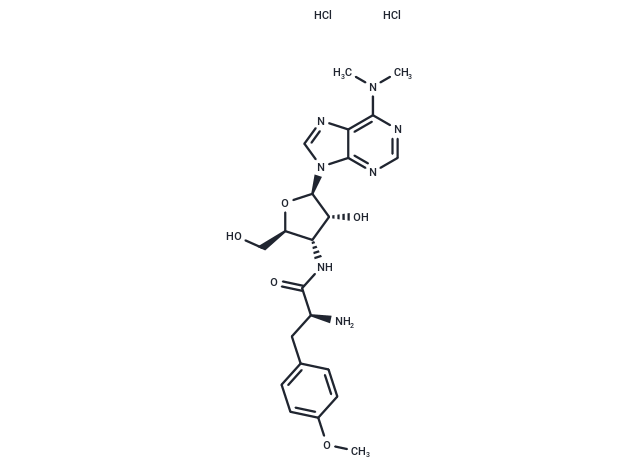Shopping Cart
Remove All Your shopping cart is currently empty
Your shopping cart is currently empty
Puromycin dihydrochloride (CL13900 dihydrochloride) is a cinnamamide adenosine antibiotic and an inhibitor of protein synthesis. Puromycin dihydrochloride inhibits protein synthesis by binding to RNA and has antitumor and antitrypanosomal activity.

| Pack Size | Price | USA Warehouse | Global Warehouse | Quantity |
|---|---|---|---|---|
| 10 mg | $39 | In Stock | In Stock | |
| 25 mg | $70 | In Stock | In Stock | |
| 50 mg | $122 | In Stock | In Stock | |
| 100 mg | $197 | In Stock | In Stock | |
| 1 mL x 10 mM (in H2O) | $43 | In Stock | In Stock |
| Description | Puromycin dihydrochloride (CL13900 dihydrochloride) is a cinnamamide adenosine antibiotic and an inhibitor of protein synthesis. Puromycin dihydrochloride inhibits protein synthesis by binding to RNA and has antitumor and antitrypanosomal activity. |
| Targets&IC50 | K562 cells:0.22 μM, A549 cells:300 nM, HEK293T cells:0.42 μM (CC50), PRH cells:2000 nM, HepG2 cells:1600 μM, KB-3-1 cells:0.21 μM, J774.A1 cells:10 μM, MOLT-4 cells:0.17 μM (EC50), HEK293 cells:0.35 nM, KB-V1 cells:79.3 μM |
| In vitro | METHODS: Human hepatocellular carcinoma cells, HepG2, and primary rat hepatocytes, PRH, were treated with Puromycin dihydrochloride (0-300 µmol/L) for 72 h, and cell growth inhibition was detected by MTT. RESULTS: Puromycin dihydrochloride dose-dependently inhibited the growth of HepG2 and PRH cells, with IC50s of 1600 μmol/L and 2000 nmol/L, respectively.[1] METHODS: Human breast cancer cells MDA-MB-231 and MDA-MB-436 were transfected with shRNAs-Puro lentivirus, and after 24 h, the transfected cells were cultured in new medium containing Puromycin dihydrochloride (1 μg/ml) for about 12 days, and then the cells were screened for the success of transfection. RESULTS: Puromycin dihydrochloride screened the lentivirally transfected cells successfully. [2] METHODS: Cells transfected with lentivirus were cultured in medium supplemented with Puromycin dihydrochloride (2 μg/mL). RESULTS: Puromycin dihydrochloride screened and maintained lentivirally successfully transfected cells. [3] |
| In vivo | Puromycin is utilized to select recombinant cells from non-cultured cells. It serves as a tool for studying protein synthesis in many systems. |
| Synonyms | Puromycin 2HCl, CL13900 dihydrochloride |
| Molecular Weight | 544.44 |
| Formula | C22H31Cl2N7O5 |
| Cas No. | 58-58-2 |
| Smiles | Cl.Cl.COc1ccc(C[C@H](N)C(=O)N[C@@H]2[C@@H](CO)O[C@H]([C@@H]2O)n2cnc3c(ncnc23)N(C)C)cc1 |
| Relative Density. | no data available |
| Storage | store at low temperature | Powder: -20°C for 3 years | In solvent: -80°C for 1 year | Shipping with blue ice/Shipping at ambient temperature. | |||||||||||||||||||||||||||||||||||
| Solubility Information | H2O: 92 mg/mL (168.98 mM), Sonication is recommended. Ethanol: < 1 mg/mL (insoluble or slightly soluble) DMSO: 255 mg/mL (468.37 mM), Sonication is recommended. | |||||||||||||||||||||||||||||||||||
| In Vivo Formulation | 10% DMSO+40% PEG300+5% Tween 80+45% Saline: 5 mg/mL (9.18 mM), Sonication is recommended. Please add the solvents sequentially, clarifying the solution as much as possible before adding the next one. Dissolve by heating and/or sonication if necessary. Working solution is recommended to be prepared and used immediately. The formulation provided above is for reference purposes only. In vivo formulations may vary and should be modified based on specific experimental conditions. | |||||||||||||||||||||||||||||||||||
Solution Preparation Table | ||||||||||||||||||||||||||||||||||||
H2O/DMSO
| ||||||||||||||||||||||||||||||||||||
| Size | Quantity | Unit Price | Amount | Operation |
|---|

Copyright © 2015-2025 TargetMol Chemicals Inc. All Rights Reserved.